Fantasia 2017, Day 3, Part 2: Genre Shift (Mohawk)
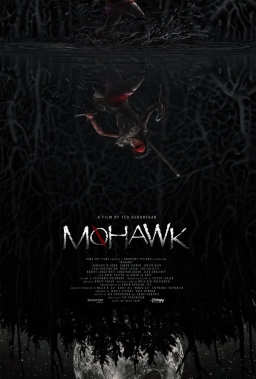 After seeing two showcases of short films on the afternoon of Saturday, July 15, in the evening I went to my first movie of the 2017 Fantasia festival to screen in the 400-seat D.B. Clarke Theatre. That was a film called Mohawk. Directed by Ted Geoghegan, his second film after 2015’s We Are Still Here, with a script by Geoghegan and Grady Hendrix, it tells a story from the War of 1812. In upstate New York a British agent, Joshua (Eamon Farren, Richard Horne on Twin Peaks: The Return), is in a polyamorous relationship with a Mohawk woman, Oak (Kaniehtiio Horn), and a Mohawk man, Calvin (Justin Rain). Calvin’s stirred up American soldiers in the area by an injudicious attack; when Joshua meets a unit of about a half-dozen Yanks in the woods, Calvin and Oak save him — but the confrontation turns into a running battle. The brutality mounts, revelations are made at inopportune times, and an image from a dream recurs.
After seeing two showcases of short films on the afternoon of Saturday, July 15, in the evening I went to my first movie of the 2017 Fantasia festival to screen in the 400-seat D.B. Clarke Theatre. That was a film called Mohawk. Directed by Ted Geoghegan, his second film after 2015’s We Are Still Here, with a script by Geoghegan and Grady Hendrix, it tells a story from the War of 1812. In upstate New York a British agent, Joshua (Eamon Farren, Richard Horne on Twin Peaks: The Return), is in a polyamorous relationship with a Mohawk woman, Oak (Kaniehtiio Horn), and a Mohawk man, Calvin (Justin Rain). Calvin’s stirred up American soldiers in the area by an injudicious attack; when Joshua meets a unit of about a half-dozen Yanks in the woods, Calvin and Oak save him — but the confrontation turns into a running battle. The brutality mounts, revelations are made at inopportune times, and an image from a dream recurs.
This is less an action film than a suspense film, built around two small groups chasing each other through the woods. The focus is admirable, but the last act of the movie drifts from suspense into fantasy-horror — or, perhaps, into a dark super-hero story. To me, there isn’t enough groundwork earlier in the film setting up the movement into fantasy. Viewers more sympathetic to the genre shift will appreciate the movie more, although I think there are a few other issues with it as well.
Before discussing the storytelling, it is perhaps worth talking about the film’s portrayal of the Mohawks in the context of a violent historical adventure. Notably, it avoids a lot of action-film clichés and imagery. This is clearly a movie that wants to be on the Mohawks’ side; I suspect audiences will have varying opinions of how well it succeeds at that. I can say that at the question-and-answer period after the film, Horn and Rain were clearly proud of their work and the story of the film. I can also say that a non-Indigenous friend of mine who works with First Nations people left the screening early.
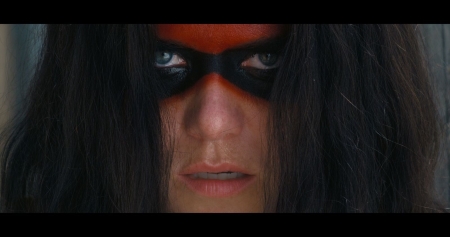 Having very little personal knowledge of these issues, I was struck by the film’s depiction of whites relative to the Mohawks. Specifically, I was waiting for a reversal involving the character of Joshua that never really came. The first scene of the movie is a confrontation between Joshua and an elder Mohawk woman named Wentahawi (Sheri Foster) in which Joshua urges the Mohawks to ally with the British to fight the United States, while Wentahawi distrusts him, telling Oak “The Britisher only wants to use your body to protect him from American bullets! And to keep you both warm at night!” It’s a strong line, but it receives no real follow-up and not much support in the rest of the movie. She may be right — but events forestall a real determination of Joshua’s attitude one way or another. Maybe more to the point, the scene sets an older First Nations woman against a young white man. It strikes me that North American filmgoers have been trained to view one of these two people as a heroic lead, and it’s not the person with whom the movie is theoretically more aligned.
Having very little personal knowledge of these issues, I was struck by the film’s depiction of whites relative to the Mohawks. Specifically, I was waiting for a reversal involving the character of Joshua that never really came. The first scene of the movie is a confrontation between Joshua and an elder Mohawk woman named Wentahawi (Sheri Foster) in which Joshua urges the Mohawks to ally with the British to fight the United States, while Wentahawi distrusts him, telling Oak “The Britisher only wants to use your body to protect him from American bullets! And to keep you both warm at night!” It’s a strong line, but it receives no real follow-up and not much support in the rest of the movie. She may be right — but events forestall a real determination of Joshua’s attitude one way or another. Maybe more to the point, the scene sets an older First Nations woman against a young white man. It strikes me that North American filmgoers have been trained to view one of these two people as a heroic lead, and it’s not the person with whom the movie is theoretically more aligned.
I should also perhaps note here that as a Canadian, viewing the Yanks as the villains isn’t a stretch, particularly in the context of the War of 1812. I don’t know how much an American would react differently to the movie, whether it would take longer to accept American soldiers as the antagonists, or whether the film overall would feel more subversive. It is clear that, while they’re reasonably humanised and individualised, the American soldiers are the bad guys who are led by a bad man. And they also struck me as positioned at the head of a lineage: a torture scene early on echoes horrors from the Iraq war, while the general feel of American military men facing guerilla combat and booby-traps in their enemy’s home wilderness subverts any number of Vietnam movies — colonialist Americans are interlopers, here as there, so to this extent the movie reminds us that what we now think of as heartland (whether of Canada or the United States) was and is a product of war and conquest.
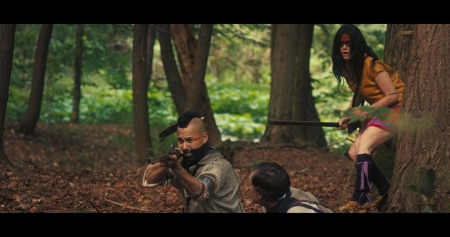 Thematic concerns aside, as a small-scale action film I found Mohawk a mixed bag. The depiction of period musketry and gunplay was generally very good, using the inconvenience and slow reloading of early firearms to fine effect in pacing and building tension. On the other hand, some of the staging choices are odd; characters never seem to see each other coming in relatively bright woods. There’s a sequence around a cave in which the American soldiers seem to abandon all common sense. And a second-act climax at a mission is undercut when one group manages to arrive there before the other, by means that are at least to me opaque. The third act is yet more baffling, though, as one character gains supernatural gifts with no clear limits; it becomes difficult to feel any dramatic tension.
Thematic concerns aside, as a small-scale action film I found Mohawk a mixed bag. The depiction of period musketry and gunplay was generally very good, using the inconvenience and slow reloading of early firearms to fine effect in pacing and building tension. On the other hand, some of the staging choices are odd; characters never seem to see each other coming in relatively bright woods. There’s a sequence around a cave in which the American soldiers seem to abandon all common sense. And a second-act climax at a mission is undercut when one group manages to arrive there before the other, by means that are at least to me opaque. The third act is yet more baffling, though, as one character gains supernatural gifts with no clear limits; it becomes difficult to feel any dramatic tension.
The characters are serviceable. I found the heroes somewhat underwritten, though the performances go a fair distance toward making up for that — especially in the case of Horn, whose Oak moves more and more to the fore as the film goes on. The Americans are given easily-distinguishable visual tags as well as broad personalities. There’s enough to them that they become individuals, but with the possible exception of huge Lachlan Alsopp (Jonathan Huber, also known to WWE fans as Luke Harper), there’s no risk of them becoming sympathetic. Unfortunately, that lack of depth also makes them difficult to take seriously; when one of them mutters “There’s a devil in these woods” you don’t really feel the atmosphere.
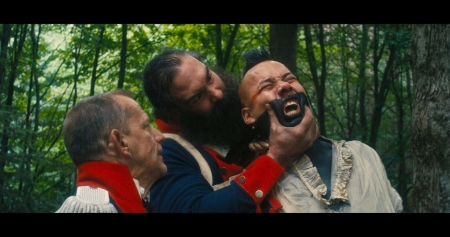 This may in part be a function of a lack of any visual atmosphere to the forests in which the running battle takes place. To a point I can understand not wanting to romanticise the Mohawk land, but the well-lit open woods here add nothing to the tone of the film. I’ve appreciated cinematographer Karim Hussain’s work previously (notably in last year’s Rupture), so I assume the way the woods are shot is a deliberate choice. But I don’t understand why that choice was made, or what it was supposed to bring. On the other hand, details of costume and props strike me as accurate for 1812, and while the language isn’t structured like period dialogue, it doesn’t use any anachronistic terminology either. (One American does mention “our Founding Fathers,” a term invented in its current application by Warren Harding in the 1920s; but then nothing says it couldn’t have been used as a one-off in 1812.)
This may in part be a function of a lack of any visual atmosphere to the forests in which the running battle takes place. To a point I can understand not wanting to romanticise the Mohawk land, but the well-lit open woods here add nothing to the tone of the film. I’ve appreciated cinematographer Karim Hussain’s work previously (notably in last year’s Rupture), so I assume the way the woods are shot is a deliberate choice. But I don’t understand why that choice was made, or what it was supposed to bring. On the other hand, details of costume and props strike me as accurate for 1812, and while the language isn’t structured like period dialogue, it doesn’t use any anachronistic terminology either. (One American does mention “our Founding Fathers,” a term invented in its current application by Warren Harding in the 1920s; but then nothing says it couldn’t have been used as a one-off in 1812.)
In the end, the movie can’t find a meaningful climax. One character with superhuman supernatural forces confronts another character without. There’s not much doubt about how that’ll end. That obviousness seems to me to rob the themes of their power. On the other hand, it’s also true that sometimes the obvious is not to be shunned; the movie ends with the victory of a group that doesn’t necessarily get a lot of victories in onscreen combat. It’s not impossible that there’s an audience for this film out there. I have to conclude that I’m not a part of it, in the sense that I can’t see how to make the film work for me as a story.
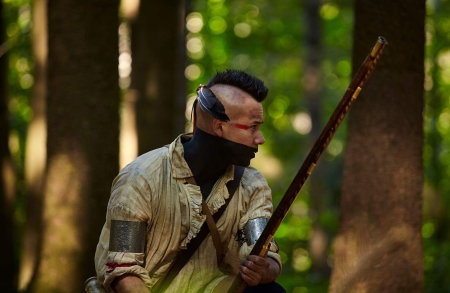 After the film, director and co-writer Ted Geoghegan (also Director of International Press Relations for Fantasia) took questions, along with Horn, Rain, and Huber. The first question was about the set-up of the 20-day shoot for the film. Geoghegan (according to my scribbled notes) said that they’d wanted to do a different kind of film, a non-horror film that was nevertheless horror. And they wanted to make something to do with current issues in North America. Their production company was surprised at the proposal for the film, but Geoghegan promised them people would talk about it. To film it they had to go into the “middle of nowhere,” but they had actors who Geoghegan felt would humanise the characters. Huber said of the filming: “I just thought that was fuckin’ awesome.” His first day shooting his first film role was a death scene: “That was my introduction to acting,” he reflected.
After the film, director and co-writer Ted Geoghegan (also Director of International Press Relations for Fantasia) took questions, along with Horn, Rain, and Huber. The first question was about the set-up of the 20-day shoot for the film. Geoghegan (according to my scribbled notes) said that they’d wanted to do a different kind of film, a non-horror film that was nevertheless horror. And they wanted to make something to do with current issues in North America. Their production company was surprised at the proposal for the film, but Geoghegan promised them people would talk about it. To film it they had to go into the “middle of nowhere,” but they had actors who Geoghegan felt would humanise the characters. Huber said of the filming: “I just thought that was fuckin’ awesome.” His first day shooting his first film role was a death scene: “That was my introduction to acting,” he reflected.
Horn talked about the difficulties of the shoot, and how emotional it was for her to see a scene in which Calvin was being tortured. In that scene he seemed to her to represent Mohawk men, and the things they had had to go through across history; she described it as horrible to watch. Huber agreed it was uncomfortable, and Geoghegan noted they’d had only two days to shoot that sequence. Rain remembered getting a rope burn from the scene. He also remembered having to shave his head for the film, and being told he had a perfect-shaped head.
The next question was about the score, and Geoghegan talked about the choice to refrain from using First Nations chants through most of the film. He said that he wasn’t sure while making the movie, but decided it was too on-the-nose to use that approach except at one crucial point. A question about casting followed, and Geoghegan recalled that he first hired Hussain to shoot the picture, and Hussain recommended Horn to him. To cast Calvin, the production was given a list of Indigenous North American actors, and in that list they found Rain and decided at once to meet with him based on a video he sent in. Huber was based close by where the film was shot, in Rochester, New York, and had six months off from wrestling due to a knee injury (thus his character wears a brace and has a notable limp).
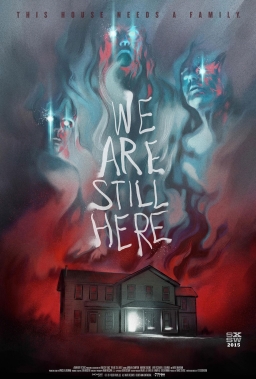 The next question was whether, given the political themes of the movie, anything had to be cut — or, conversely, whether there was anything in the movie that made it in that they’d thought would have had to go. Geoghegan said that the script was the script; conceptually, the film is what they wrote. He observed that his co-writer, Grady Hendrix, was known for his comedy-horror novels but was also obsessed with the War of 1812, with shelves full of research material. With this film, they’d wanted to establish their respect for the courage of the indigenous people of North America, and worked to craft something respectful. Geoghegan said that as someone who was LGBT he wanted to have varied relationships, hence the poly relationship among the main characters.
The next question was whether, given the political themes of the movie, anything had to be cut — or, conversely, whether there was anything in the movie that made it in that they’d thought would have had to go. Geoghegan said that the script was the script; conceptually, the film is what they wrote. He observed that his co-writer, Grady Hendrix, was known for his comedy-horror novels but was also obsessed with the War of 1812, with shelves full of research material. With this film, they’d wanted to establish their respect for the courage of the indigenous people of North America, and worked to craft something respectful. Geoghegan said that as someone who was LGBT he wanted to have varied relationships, hence the poly relationship among the main characters.
A question about the practical effects led to a discussion of the stress of shooting in Onondaga County (outside Syracuse, New York), where the heat rose to 40 degrees Celsius (105 Fahrenheit) during the day and froze at night. Huber was asked about the difference between wrestling and acting. He said the first difference was the instant gratification of wrestling — do something in the ring and the audience reacts at once, while with film you have to wait a year to get a response. Also, he continued, he knows he’s good at wrestling; he doesn’t have the same certainty about his acting.
Asked if the movie was always intended to be set entirely in the 19th century, Geoghegan said yes, although they were on the fence for a while about the exact year. They selected a time in which the Mohawks were still neutral, with the British sending agents to Mohawk villages to provoke war; he said he saw a parallel between the damage they caused and the United States in the contemporary Middle East. Their historical consultant helped a lot. They discussed Oak’s costume, which was partly dyed an unusual bright red, and how they’d wanted to bring something new and unusual to the film. They also spoke about training the cast in the use of 19th century muskets.
Next was a question about the language of the film. Geoghegan said that they decided to use a 21st century English, but kept the vocabulary limited to words used in the period. Horn helped them with lines in Mohawk, which they had always planned not to subtitle. Asked about the stunts in the film, Geoghegan said that the actors did a lot of their own stunts. Horn’s double was the stunt coordinator for the film. Huber concluded the night by observing: “I think I’d be embarrassed if I asked somebody else to do my stunts.”
That ended the questions and the answers. It had been an interesting day, and if I wasn’t sure about Mohawk as a genre piece, at least it was a movie that encouraged some historical meditation. I’d be back relatively early the next day, and I could only wonder what I’d make of what I’d see then.
(See all my 2017 Fantasia reviews here.)
Matthew David Surridge is the author of “The Word of Azrael,” from Black Gate 14. You can buy his first collection of essays, looking at some fantasy novels of the twenty-first century, here. His second collection, looking at some fantasy from the twentieth century, is here. You can find him on Facebook, or follow his Twitter account, Fell_Gard.